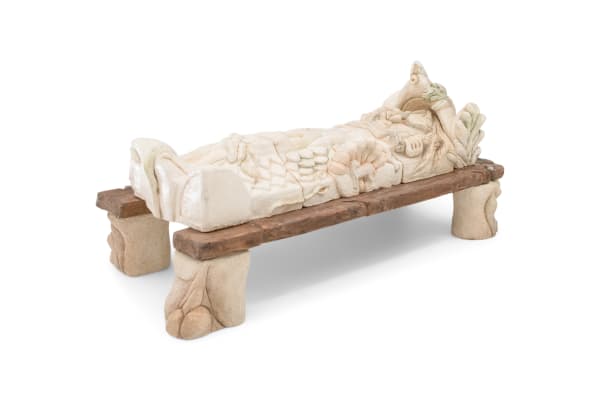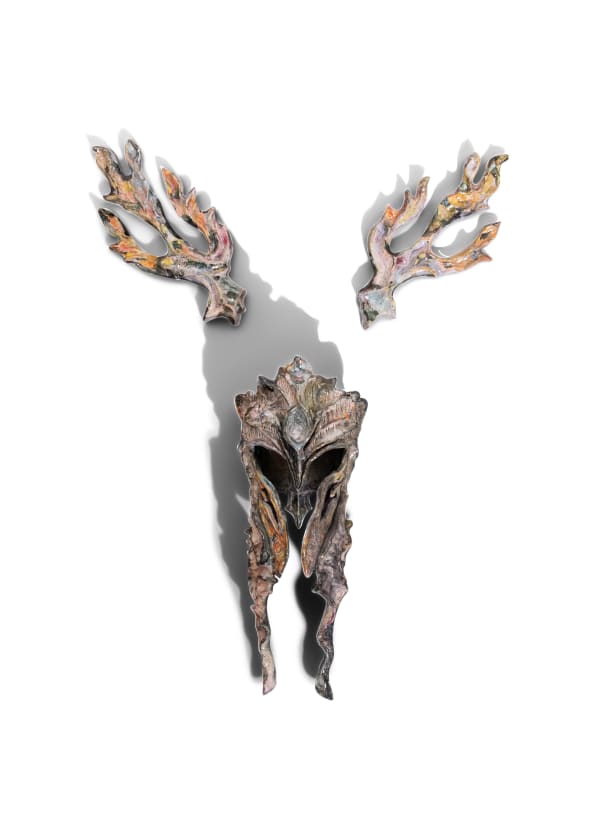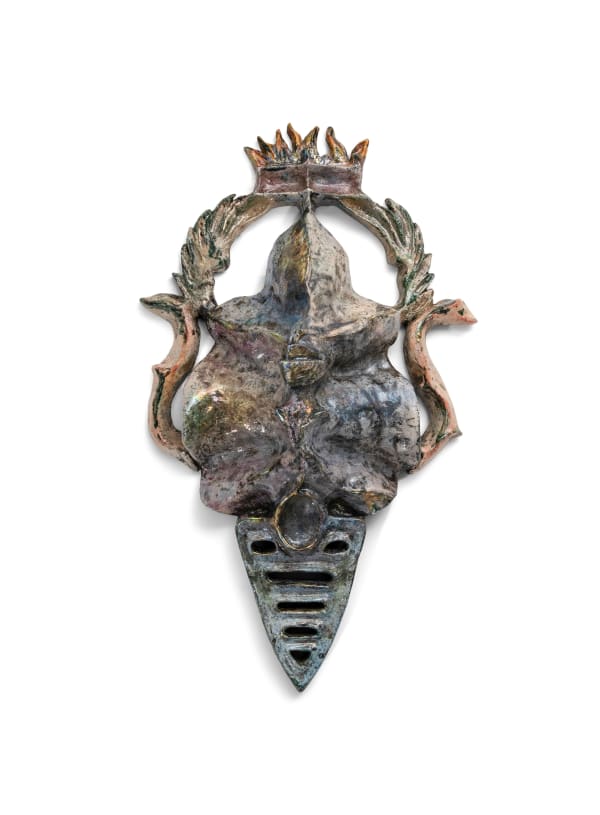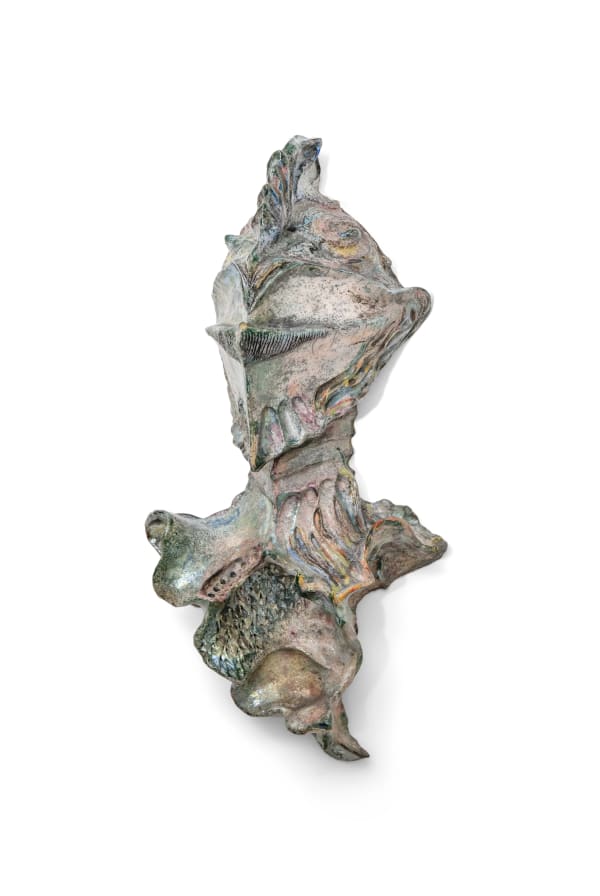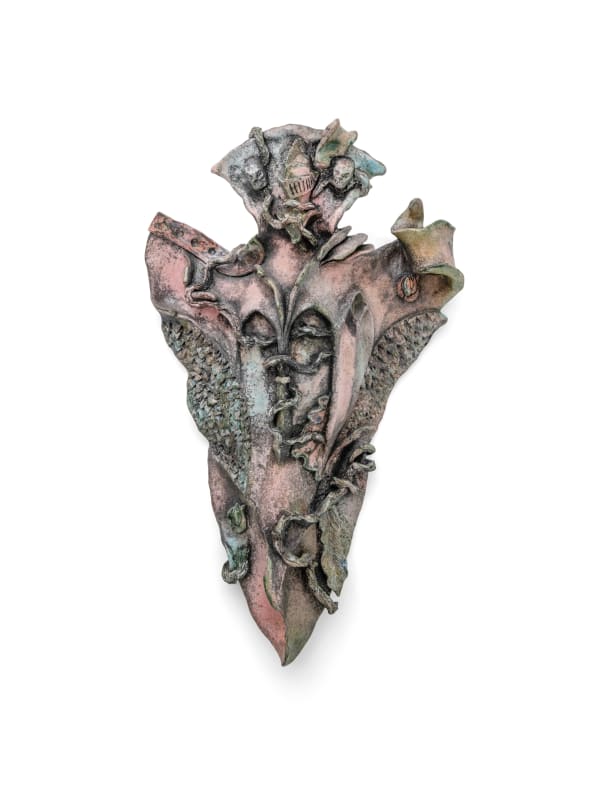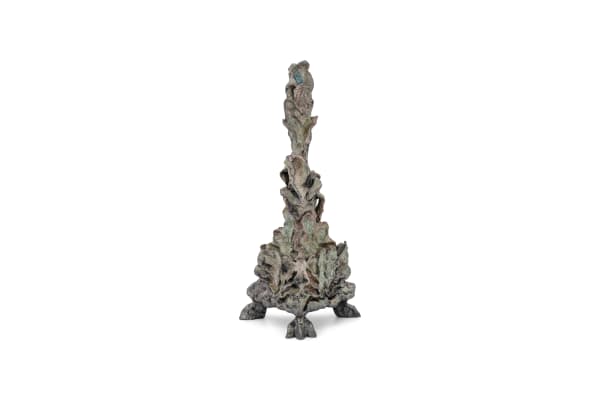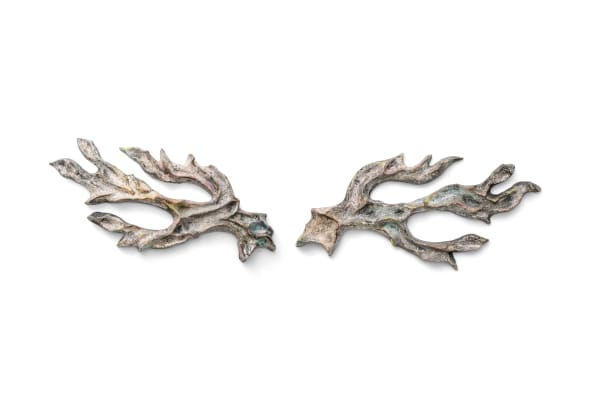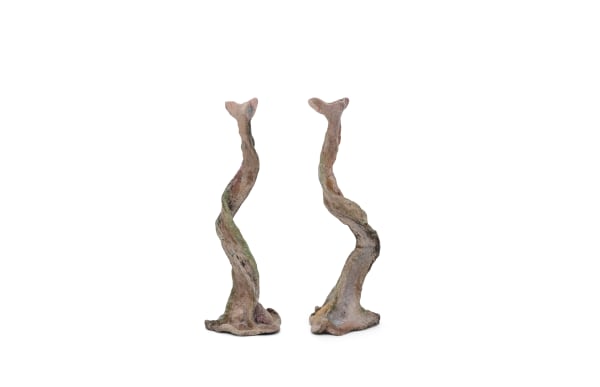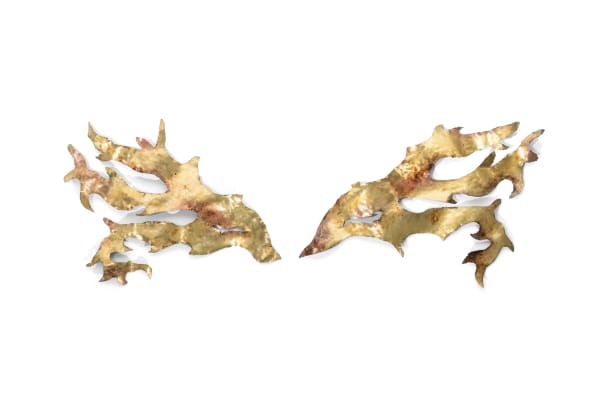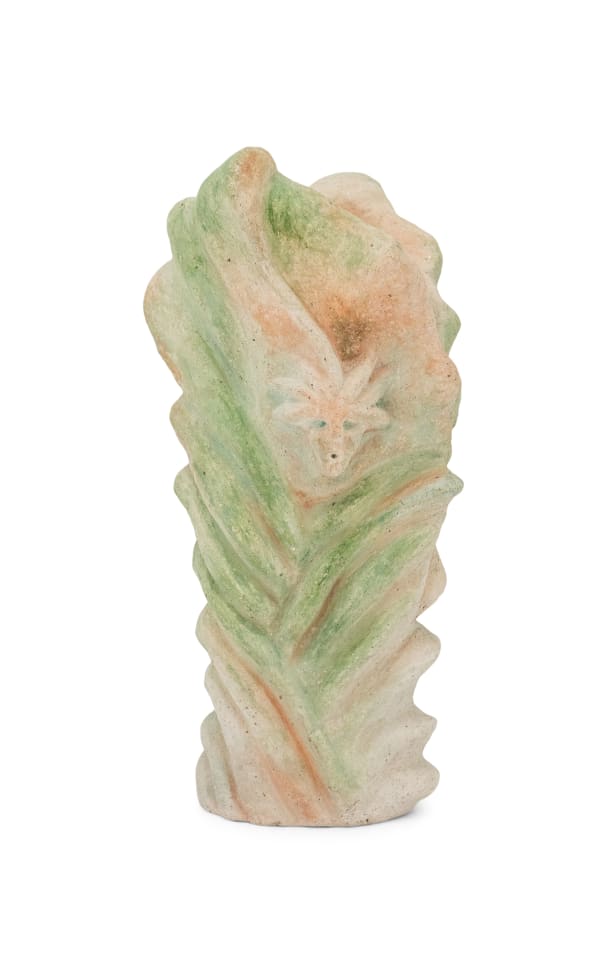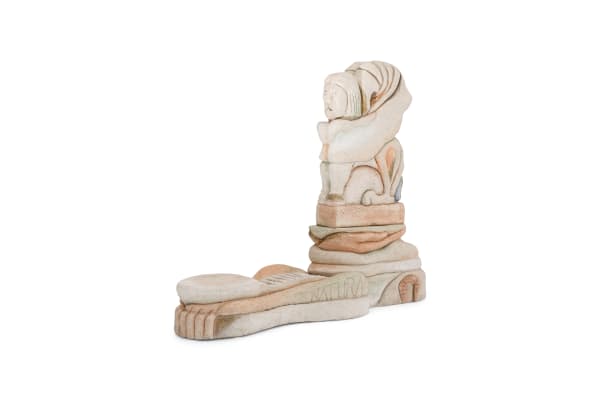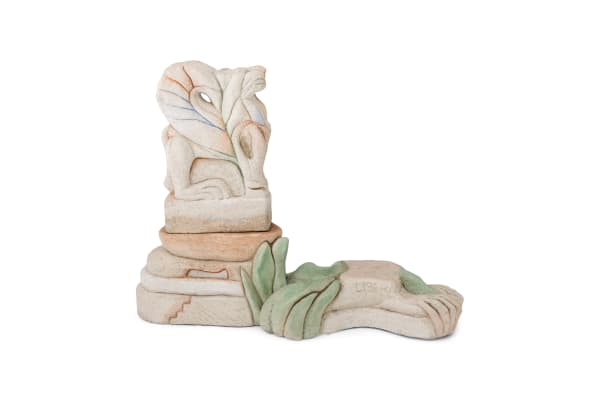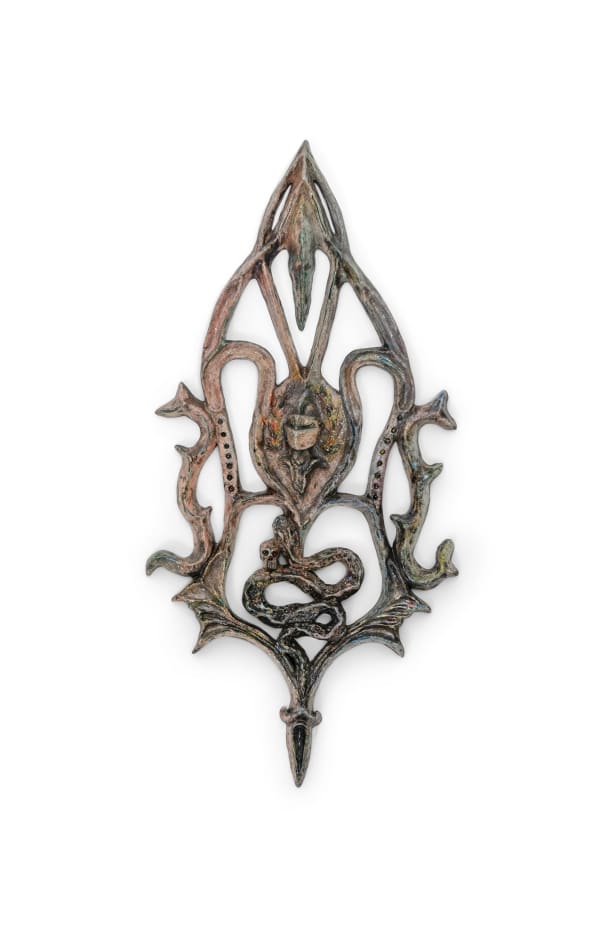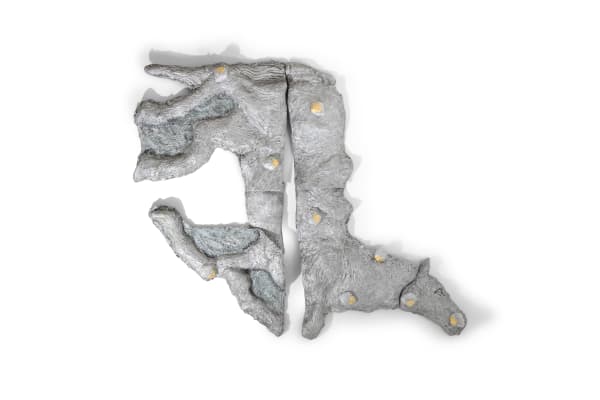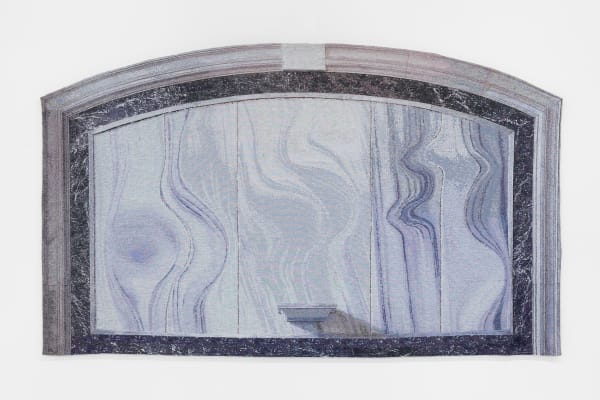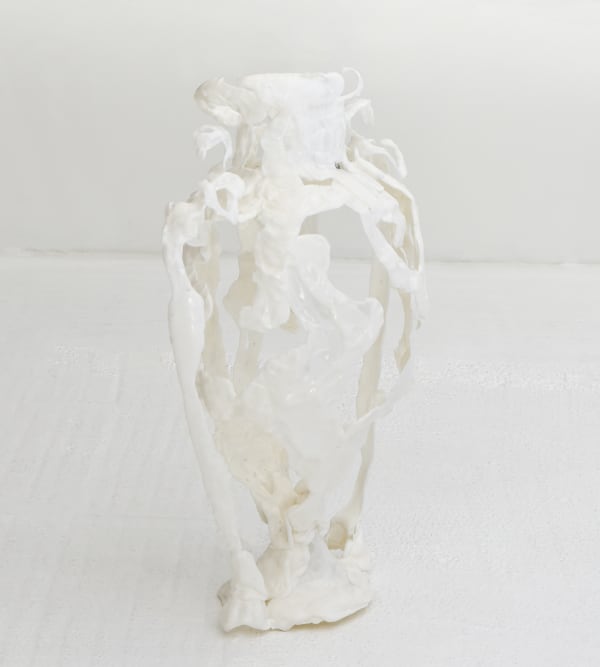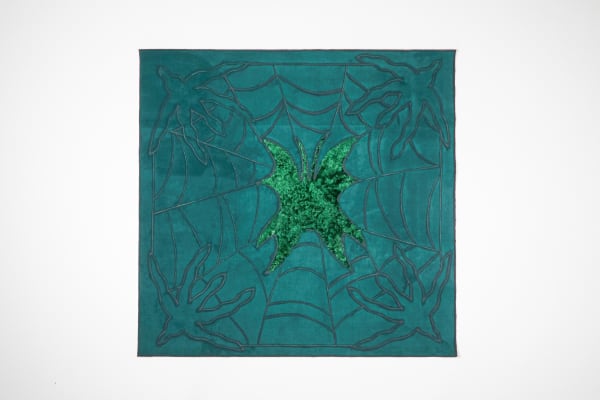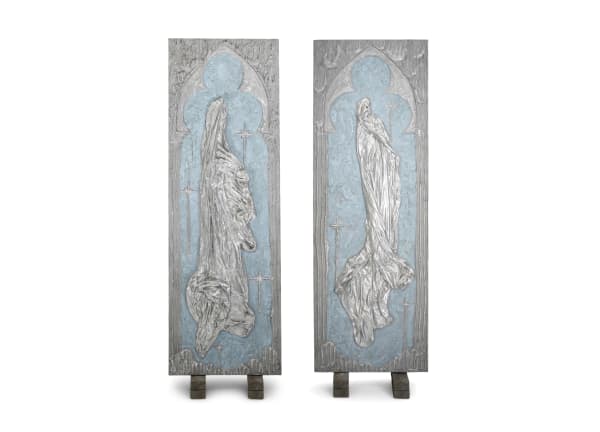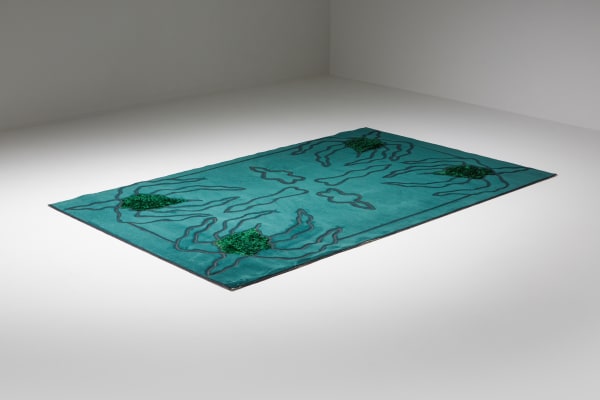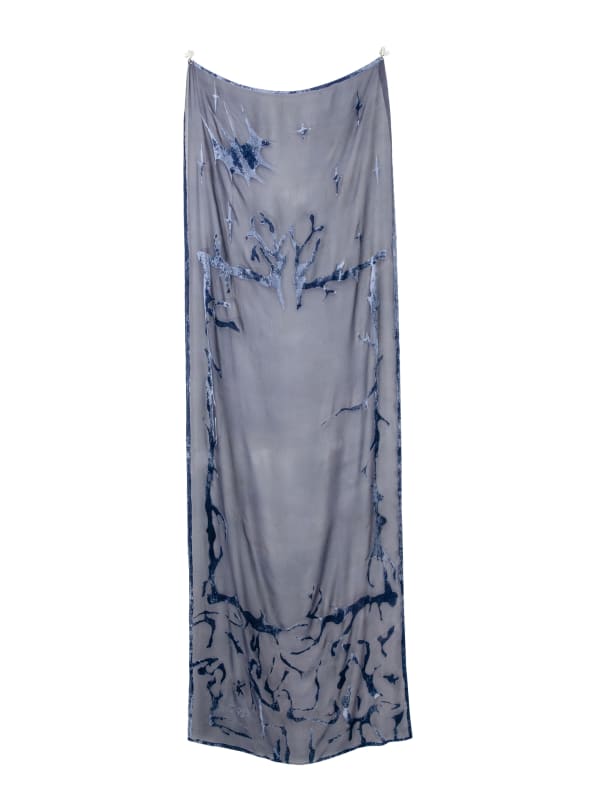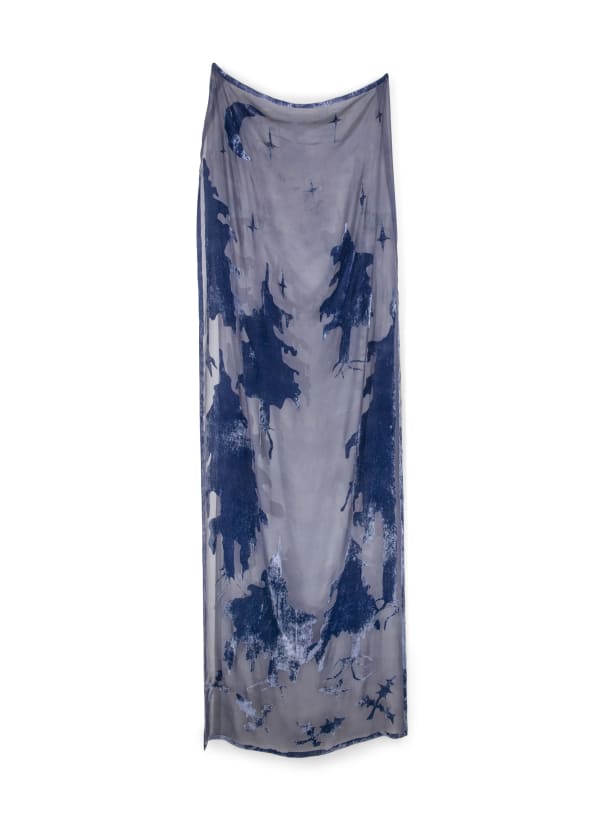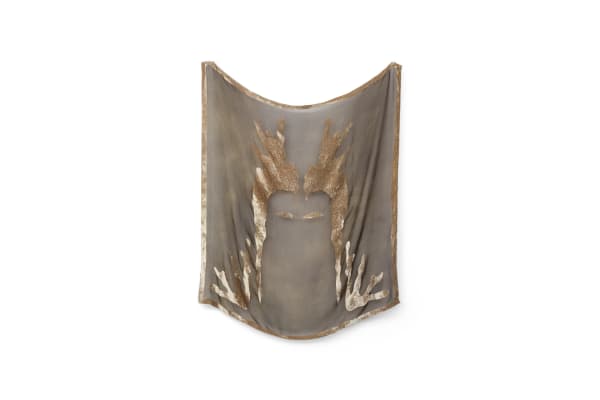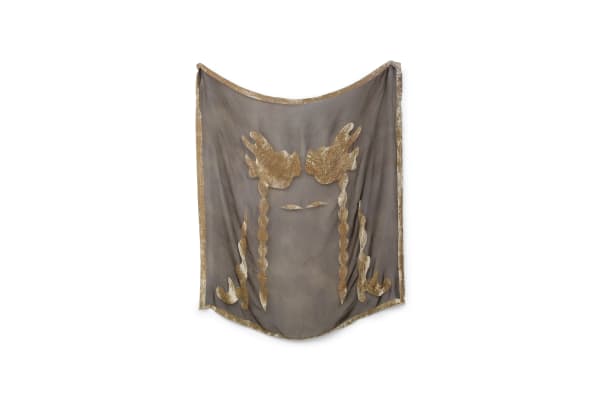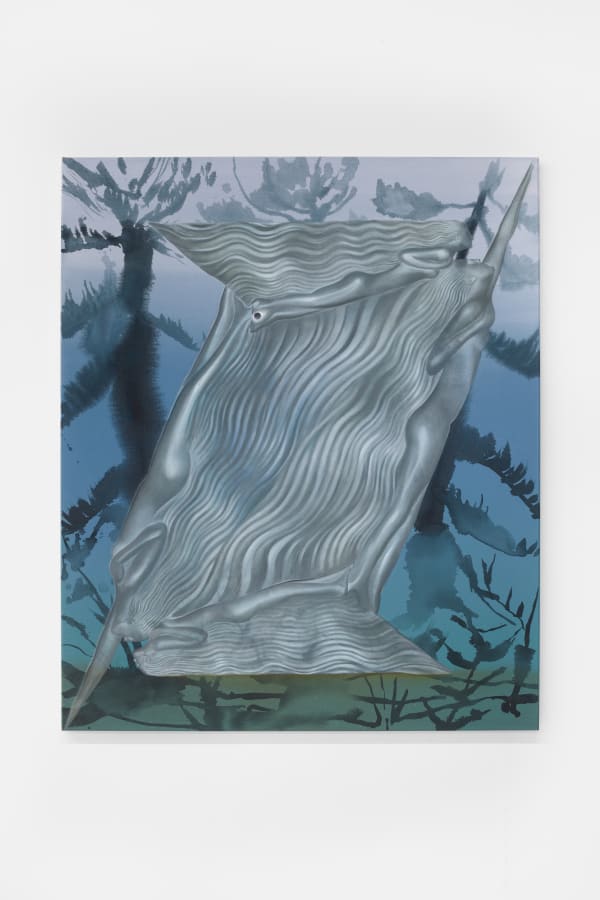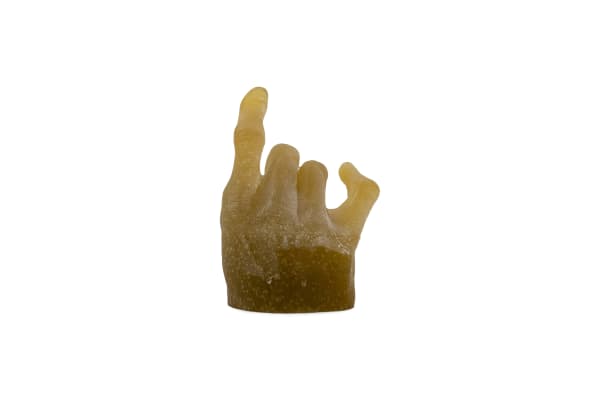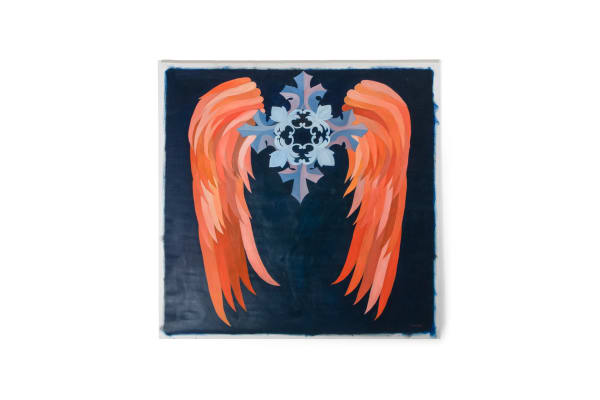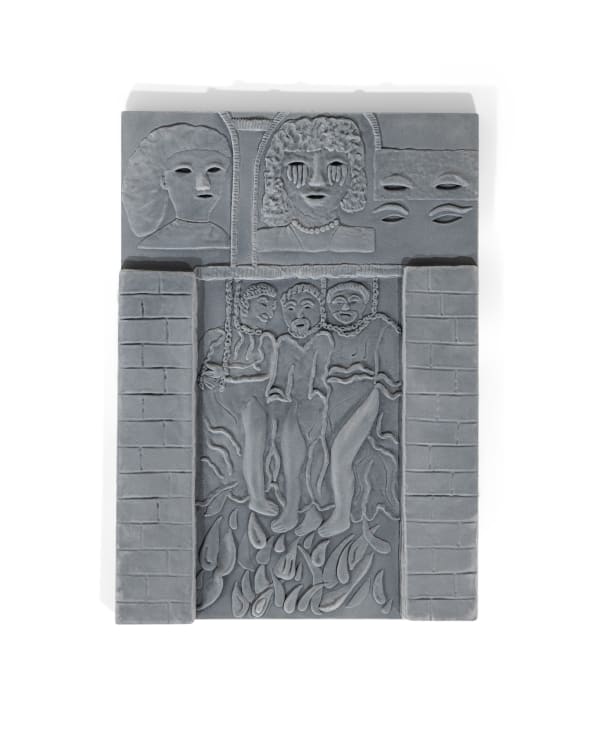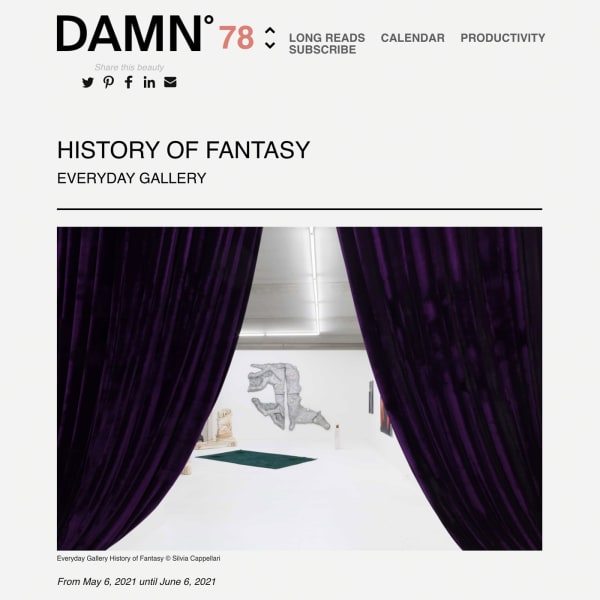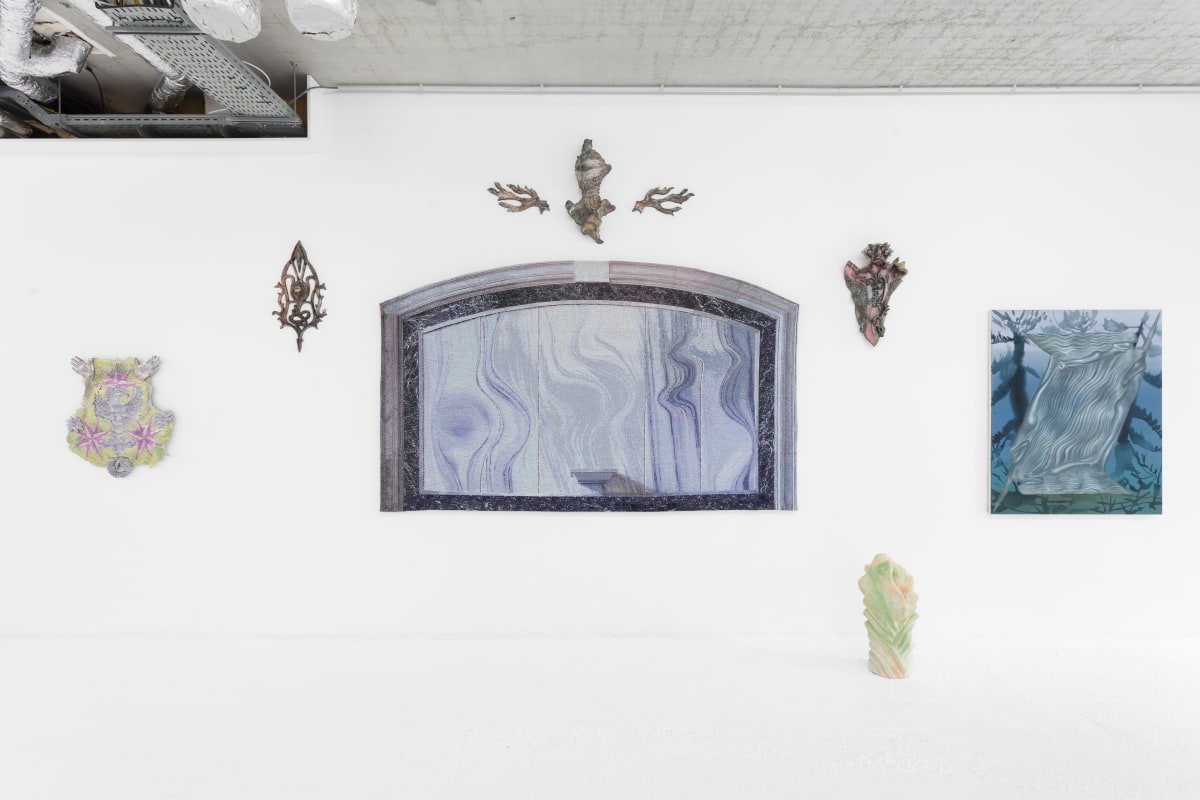'History of Fantasy' is a phantasmagorical stroll populated by ghosts, animated by a poisonous magic. It is part of the wake of a new twilight wave, a reminiscence of an underlying current that has been running through history since the end of the eighteenth century, summoning up the successive avatars of the Romantic matrix, from the neo-Gothic to the dark wave and fantasy, via the troubadour style and fin de siècle symbolism.
1 Historical wanderings
'History of Fantasy' is a historical wandering filled with memories, fantasies and recreations. Far from being considered as a uniform block, this history is the fruit of memories and absences. These historical fantasies are like escapes from the times, projecting us into other temporal dimensions, where history becomes a world in itself. The works exhibited and produced for 'History of Fantasy' explore these historical and memorial reminiscences. The inaccuracies left by the passage of time, counterbalanced by visual persistence, around motifs or forms that have entered the collective unconscious (the gothic arch, the recumbent, and other ornaments...) are sources of creation, reinvention and variation. These historical and artistic recollections are summoned by the artists in the historical walk of 'History of Fantasy'. Notably through Laure Prouvost's woven work, representing a stele, or through Bella Hunt & Ddc's Celtic-Atlantean recumbent representing an ancient warrior woman, a veritable reinvention a posteriori, or Jenna Käes' Valkyrie shrouds. These works conjure up a historical fantasy that translates into creations and formal variations, in the manner of the literary style of heroic fantasy, such as J. R. R. Tolkien's Lord of the Rings, heir to the ancient and medieval epic narrative. It is unclear whether the works of Bella Hunt & Ddc or the quasi-Parthe horse of Jean-Marie Appriou are works from forgotten civilizations or new icons of an imaginary world. The exhibition creates correspondences and tributes to the gothic and baroque architecture of Flanders, a real point of friction between the influences of northern and southern Europe and the Germanic area, from which a form of artistic fusion emerges that can be found in all the artists of 'History of Fantasy'.
2 Dark Wave and Kunstwollen
'History of Fantasy' is part of this fundamental movement linked to dark romanticism and the gothic novel, born in the eighteenth century, from the rupture of the French Revolution followed by the industrial revolution, and extending at the beginning of the nineteenth century to the whole of Europe. History becomes the space of all fantasies in counterpoint to the eternal present. Admiration for the ancient grandeur of the Renaissance and the seventeenth century already functioned as a revival; the fantasy of the past became a medium of creation. From the 1770s onwards, this calm and positive relationship with the past changed, and was no longer just a source of knowledge and inspiration. History became a refuge from the accelerating and sometimes brutal changes of modern Western societies. The upheavals of the late eighteenth century led to the emergence of a heritage consciousness and a new relationship with time, where the present is now thought of independently of the past. The Restoration and the creation of History as a discipline detached from literature and philosophy led to a renewed interest in the Middle Ages and in Gothic architecture. This gave rise to the neo-Gothic, the troubadour style and the Pre-Raphaelite group. These are not purely historicist movements; they are above all creations based on a fantasised vision (see the reconstructions of Viollet-le-Duc, the objets d'art of Félicie de Fauveau) of an admired past. This attraction to the past as a source of inspiration continued beyond the nineteenth century through the neo-Romanesque, neo-Byzantine movements, in the neo-classicism of the 1930s and even in the egyptomania of the 1920s. In the 20th century, in the post-war years and particularly from the 1970s-1980s, this underground current emerges again, embodied in a kind of "dark wave", a wave of historical fantasy as a counterpoint to the historical repression induced by the modern flight forward, then by the permanent post-modern present. Fantasy literature, in the wake of Tolkien from the 1950s onwards, medieval-fantasy role-playing games in the 1960s, and the new wave and neo-romantic current in the 1980s all appear as pure inventions built on historical reminiscences and reinterpretations, and are uchronic and alter-historical productions and fantasies. This leitmotif of historical fantasy is a manifestation of Alois Riegl's kunstwollen - the artistic will - which 'History of Fantasy' proposes to identify and analyse. This need for artists to look at history and the past is thus born of the weight of the permanent present and of the forgetting and deformations that the passage of time entails, eroding memory as the passage of water erodes rock. The alluvium, however, transported by the water, ends up aggregating again to form sedimentary layers.
3 Formal crystallisation
Like Jean-Marie Appriou and Laure Prouvost, the "History of Fantasy" artists are part of the re-emergence of this substantive trend, this neo-romanticism of the 21st century. Raphaela Vogel and Laure Prouvost approach memory through the medium of intimate and personal history, while at the same time drawing formally on old forms linked to the decorative arts and art history. This is the case with Vogel's Gothic aesthetic, which is anchored in everyday life (the vase motif), or with Prouvost's tapestry (the medium of the narrative cycle par excellence) depicting a marble wall, evoking a crypt or a Baroque chapel. Some, like Jean-Baptiste Janisset or Andrew Humke, are artists of syncretism, observing motifs, forms and ornaments, and reusing them to create new assemblages. Andrew Humke is literally a kunstwollen artist, handling ornaments which he uses on large canvases, giving a synthesis of Mediterranean popular and decorative arts. Janisset builds lead totems by assembling copies of decorations he finds on ancient buildings or tombs, bringing together in one work a diffuse set of vernacular and spiritual references and forms. In Ariana Papademetropoulos' work, the presence of a dreamlike veil over vintage interior scenes or surrealist compositions is associated with the recurrence of the hole, the crack, which are here like temporal portals, or windows on the elsewhere. In the case of Jacopo Pagin, all his works offer a re-reading of and homage to the entire history of art, both Italian and Flemish (through the contributions of the Nordic painters to Italy during the Renaissance). Subtly, he revisits the clichés of Venetian or surrealist painting, drawing on whimsical variations. These works are historical fantasies, which represent like alter-aesthetics, lateral proposals of past artistic trends. The works of Jenna Käes and Bella Hunt & Dante Di Calce are compositions that borrow from history and fantasy. Fantasy, as a literary genre, is itself a product of this phenomenon of historical fantasy, where the past, sometimes very distant, is a source of inspiration. The influence of fictional universes, such as that of the Lord of the Rings, created by the scholar J.R.R. Tolkien, hovers over the works of these artists; the helmet-shaped sconce of Bella Hunt & Ddc is a direct homage to the armour of the Elves. The very gothic pointed arches of Jenna Käes' funeral slabs are counterbalanced by reliefs depicting graceful shrouds, reminiscent of Art Nouveau lasciviousness or the delicacy of an antique drapery, and the whole evokes an unreal fairy tale. The sarcophagus may be that of an ancient warrior or a Valkyrie, to which two of Jenna Käes' shrouds, named after these mythical Scandinavian warriors, respond. Yet Bella Hunt & Ddc's ceramics, with their vibrant, metallic glazes, are as much about fanciful coats of arms as they are about reminiscent of car calendars. These works touch on the popular, the taste for cars and objects, and the practice of tuning, bringing together popular culture and references to history. Finally, Jean-Marie Appriou also delivers a visual fantasy, with this relief featuring a horse, which seems to be petrified in a swampland or buried in a pit, like the mount of a Parthian king buried with him and returning to the living. The whole of 'History of Fantasy' constitutes a total work, a visual installation in itself, in which a soundtrack composed by Kabyle Fragile is played; the invitation to Léa Porré and Igor Dubreucq to explore 'History of Fantasy' in universes linked to 3D constitutes a second escape from the exhibition space.
Here we see the emergence of historical fantasy reminding us of symbolism, dark romanticism and the gothic novel, all of which embrace popular culture, in the manner of the American high and low, linking great history and popular art.
Text by Emmanuelle Luciani
Images by Silvia Cappellari
History of Fantasy (a Group Show)
Thursday 6th May 2021 - Saturday 12th June
On Thursday May 6, Everyday Gallery opens History of Fantasy, an exhibition of works by a close-knit group of artists curated by acclaimed curator Emmanuelle Luciani (Southway Studio).
The solitude that comes with social distancing also provides us with an opportunity to explore our personal and collective fantasies – online, offline and, most importantly, through art. When no one is watching - and more importantly perhaps, when no one is judging - which fantasies do we explore? And which fantasies would we want to explore collectively?
Following the success of their group exhibition Anima Mundi on Manifesto 13 in 2020 (also curated by Emmanuelle Luciani), History of Fantasy features a close-knit group of established and upcoming artists that collectively engage in an exuberant and playful exercise in constructing off the grid fantasies. History, they suggest, is full of holes, full of unexplored and untapped fantasies and images. So why not revisit and re-envision these fantasies, joyfully splicing different memories and histories together?
History of Fantasy features well-established artists like Turner-prize winner Laure Prouvost, Los Angeles based painter Ariana Papademetropoulos, and Jean-Marie Appriou with work in the collection of Musée d’Art Moderne de Paris; Fondation Louis Vuitton, as well as up-and-coming names like Jean-Baptiste Janisset, Jenna Kaës, Mamali Shafahi, Andrew Humke, and collaborative duo Bella Hunt and Dande Di Cale. In close interaction with each other, they will contribute works that together create a syncretic universe of wildly diverse forms of imagination, historical traditions and images. History of Fantasy offers a chance to envision alternative histories, phantasmagoric desires and alternate timelines that promise to reinvigorate our everyday lives in unexpected ways.


